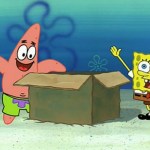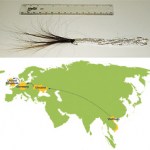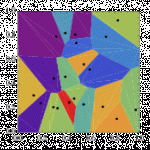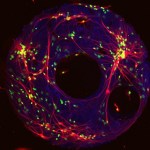Technology
The 3D reconstruction [(A) to (E)] of coxa (green) and trochanter (yellow) of left hind leg of T. oblongus. (A) Depressed position. (B) Elevated position. (C) Coxa cut horizontally along rotation axis; dorsal aspect of trochanter while leg depressed. (D). Isolated trochanter showing external spiral thread and tendon (t). (E) Dorsal portion of coxa corresponding to ventral portion of (C). (F) Scanning electron microscope photograph of the right metatrochanter showing posterior condyle (c) and external spiral thread (e).
This stunning image reveals for the first time that beetles use a…
Beauty can be everlasting, ephemeral {internet sensations} and above all else, in the eye of the beholder. Poets and artists have explored this mystery for centuries, but can science reveal new insights?
Ed Yong at DiscoverBlogs recently wrote about a fascinating brain imaging study done that begins to address this question, exploring visual and musical stimuli. Yes, beauty can be express itself in many other ways, but this is a start.
Tomohiro Ishizu and Semir Zeki from University College London watched the brains of 21 volunteers as they looked at 30 paintings and listened to 30…
Photo source.
This is a guest post co-written with Nathaniel Epstein-Toney.
SpongeBob and Patrick's episode "Idiot Box" (2002) brillinatly portrayed imagination games inside a cardboard box. Could it (Did it?) inspire the 3D virtual box or the 3D virtual CAVE?
We believe it could have. No, SpongeBob and Patrick are not scientists. But their playfulness and imagination is the very essence of scientific discoveries. If you have not experienced a 3D virtual box or a 3D CAVE, in which you are fully immersed in a 3D environment, a reminder of this wonderful episode may give you an idea:
From…
I'm going to be at an amusement park tomorrow, for a meeting of the APS's Committee on Informing the Public, which oversees the APS outreach program. Why an amusement park? Because a common outreach-type program is to do a Physics Day at an amusement park and talk about the physics of roller coasters and the like. And why should we miss out on all that fun? we have a responsibility to make sure that the physics content of these programs is sound.
As part of this, I'll be going on a bunch of rides-- for SCIENCE, mind you-- and it occurs to me that while the park or the APS may supply some sort…
Wolfram Meier-Augenstein
Tragic Trajectory Forensic researchers used this 14-cm lock of hair to map a dead man's route to the U.K.
Measuring isotopes has come a long way. Recent reports describe an emerging field of environmental forensics. Where did those illegal drugs come from? Is that $1,000 bottle of scotch the real deal?
According to Chemical & Engineering News:
An analytical chemist at James Hutton Institute, in Dundee, Scotland, Meier-Augenstein has pioneered a way to help determine where unidentified victims like this one lived or traveled. To do so, he measures the stable…
I've received a suggestion that one potential source of a lot of the recent nonsensical creationist literature-quoting has a plausible source: Jerry Bergman. That guy is completely nuts, as I learned in a debate a while back; he's also pretentious while not knowing much, and he's painfully prolific, publishing lots in fringey creationist pseudo-journals.
So now I have a technical question. I have a DVD copy of that wretched debate, and I've even gone so far as to rip it, and now have five MP4 files sitting on my computer (I also have a folder of the raw ripped files, a bunch of .bup, .ifo, .…
Artist Mike Bodge has unveiled a nifty project to chart the colour of the sky above New York City in real time. A camera installed in his office snaps a picture of the skyline every five minutes, and analyses the image to calculate its average colour. The varying shades of blue, grey, orange and black are posted online in a never-ending mosaic.
Mike says:
Many of my projects tend to be about New York City, as it's a place i'm constantly inspired by. I have a great view at my office overlooking the East Village neighborhood and I've done time lapses and other things but none really…
From the Journal of Things Kurt Vonnegut Warned Us About, Japanese scientists have discovered a way to make water freeze at room temperature.
Image CC Nicholas Bufford
The team of scientists were investigating the properties of water molecules wrapped in single-atom thick carbon nanotubes. The nanoconfined water displayed several unusual properties. Most striking was that as the width of the carbon nanotube decreased, the melting point of the water trapped inside rose. These "tubule ices" are unlike any seen in bulk water, and can even occur at room temperatures.
Thankfully, there's no…
Philosopher and mathematician René Descartes proposed some curious diagrams in 1644. A biologist looking at these shapes might think of living cells under a microscope:
Source.
Compare these shapes to epidermal cells {in this case, the epidermal surface of lamprey larvae. Note that this image is from the wonderful Cell Image Library.)
These designs, also known as "Voronoi diagrams," have found useful applications in a wide range of fields, including medicine such as:
...finding the best location for a hospital based on the locations of surrounding residents can
be obtained by using…
He's completely lost me again. Brown has a couple of posts up complaining about people referring to mental illness as a "brain disease" and confusing mind with brain — he seems to deplore the growing recognition that the mind is entirely a product of the brain, and that psychology is built on a physical substrate, which leads to what he thinks is a premature reduction of mind to brain. He's not making an argument from dualism, though; the gist of his complaint is that you can't deduce thoughts from the structure of the brain, therefore it's an invalid approach.
That doesn't make any sense. We…
What constitutes consciousness? How do you define a person? These are deep philosophical questions that I cannot answer, but MSNBC political commentator Rachel Maddow took them on - prompted, surprisingly, by one of my recent blogs "Growing a Brain in a Dish."
My earlier blog was more focused on my enthusiasm of the discovery that researchers could grow brain cells on a petri dish that were connected both physically and by electrical and chemical signals. I'll let The Maddow Blog explain, as it is more clear than my earlier post and then goes on to the deeper questions - and so I was "…
"All things move and nothing remains still" -- Heraclitus
The history of astronomy can be read as a story of better and better vision. Over the centuries, we have supplemented our vision with technology that allows us to see further and more clearly; while Ancient astronomers, who relied only on their naked eyes to perceive the universe, managed to make star catalogues and predict comets, Galileo, pressing his to a telescope, saw all the way to the moons of Jupiter.
Optical telescopes and the human eye are fundamentally limited; early astronomers were forced to gaze into telescopes for…
Apropos Linux in Exile losing his Linux System to a Predatory Windows Install the other day (see Windows killed my laptop, again) I've been thinking about and beginning to do something about cleaning house. See below for my latest Windows mini-horror story (not as bad as LIE's). But first, a word about Cthulhu. Who lives in my blog cave.
I have three computers sitting here in the blog cave, two of which I use on a regular basis. The Windows computer is used at this time only for scanning slides because the software that comes with the scanner for Windows is convenient and nice and the…
This is incredible, from The Wall Street Journal!!
"I panicked and said I was hacked," said Mr. Weiner at the late afternoon news conference at a midtown Manhattan hotel.
What was he thinking?
See my previous post, giving him the benefit of doubt. So much for the dangers of hacking and computer privacy in this case, but it's all too real.
Excerpts:
New York Rep. Anthony Weiner on Monday admitted sending sexually suggestive photographs to women online but said he doesn't plan to resign from Congress because of the scandal.
"I panicked and said I was hacked," said Mr. Weiner at the late…
British teenage students have re-discovered a classical physical phenomenon, the Leidenfrost effect that could someday help ships glide through oceans more efficiently.
I'll let these 16 year old students explain it:
One day in Physics class we accidentally discovered you could get beautiful standing wave patterns on a drop of water on a very hot plate. This film gives an introduction to the wonderful Leidenfrost Effect.
The film was made by 16 students (aged around 16) - only three appear in the film, but everyone helped, as did their physics teacher. You can watch the video here.
Below I…
One of the tabs I opened last week and didn't have time to get to was this Clastic Detritus post about what it takes to get science stories in the media, which is (quoting Michael Lemonick):
I get it that a stories involving science need a little something extra to make it in a magazine like Time or even near the front pages of a mainstream newspaper. Or, put another way:
It should be surprising, important -- or weird and fun, failing the important.
I get it that the average non-scientist out there isn't going to take the time to read an article about "ordinary" science. I get it. Our…
Source.
The recent news media storm about Rep. Anthony Weiner (D-NY) and the "Twitter prank" highlights the importance of internet safety and security. It is not surprising that someone could hack into a public official's Twitter account and post an embarrassing picture. But online social networks are only part of the story, and ad blockers may be your best ally.
A study recently presented at the Web 2.0 Security and Privacy conference in Oakland, California is, well, terrifying. Consider this, from the AT&T Labs and Worcester Polytechnic Institute researchers' abstract, testing more…
Sometimes you wake up and you think of a really good idea and then after a couple of hours trying to find out how QR patterns are encoded you remember to Google your idea and find someone's already done it.
But I don't mind. Check out this sweet QR code clock by QR Planet.
In case you're wondering, a QR code is simply a two-dimensional barcode. It's a way of packing a lot of machine-readable data into a small space. QR patterns can encode URLs, text, phone numbers, and contact details. You can scan them with your cameraphone if you have the right software - there's plenty of free…
(This post is part of the new round of interviews of non-academic scientists, giving the responses of Adam DeConinck, who works at a company providing supercomputing resources. The goal is to provide some additional information for science students thinking about their fiuture careers, describing options beyond the assumed default Ph.D.--post-doc--academic-job track.)
1) What is your non-academic job?
I work as a systems engineer at R Systems, a company that provides high-performance computing (HPC) resources to the commercial and academic research communities. We own and operate a number of…
I feel a little bit guilty saying this: every time I write about Jonah Lehrer, it seems to be about jumping on his ideas, even though I think he's a good writer and his other ideas, the ones I don't carp about, are interesting. The last time was when I criticized his noise about how science is falling, and now he's gotten on the "The internet is making us stupider" bandwagon. I think it is a silly argument; it's essentially saying that making the exchange of ideas more free leads to greater ignorance about the diversity of opinions out there.
It's just not true. I'm an admitted lefty liberal…











